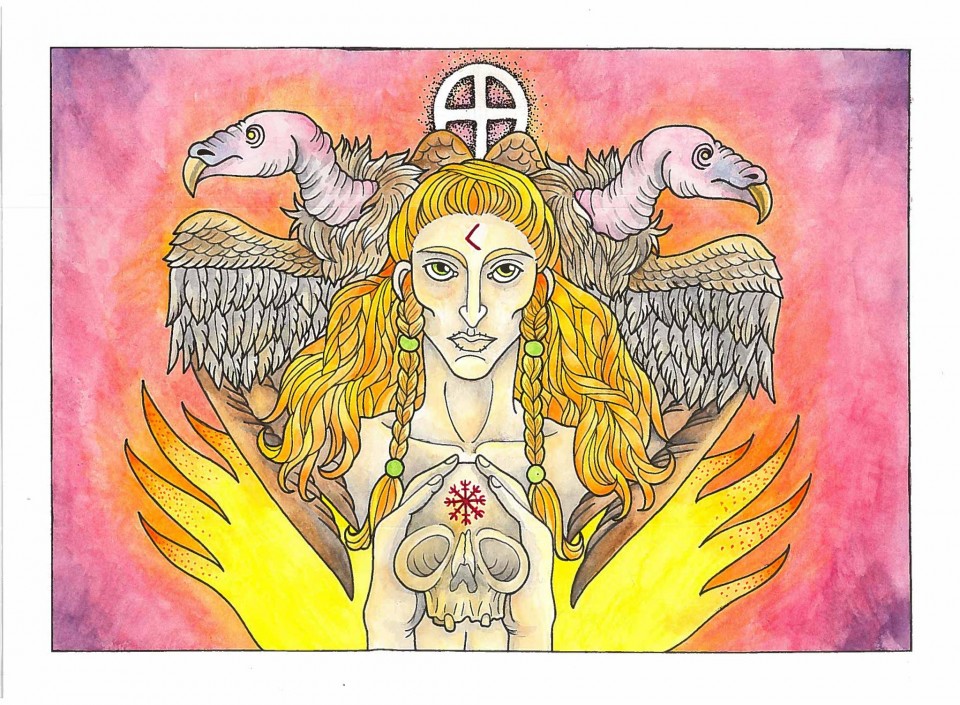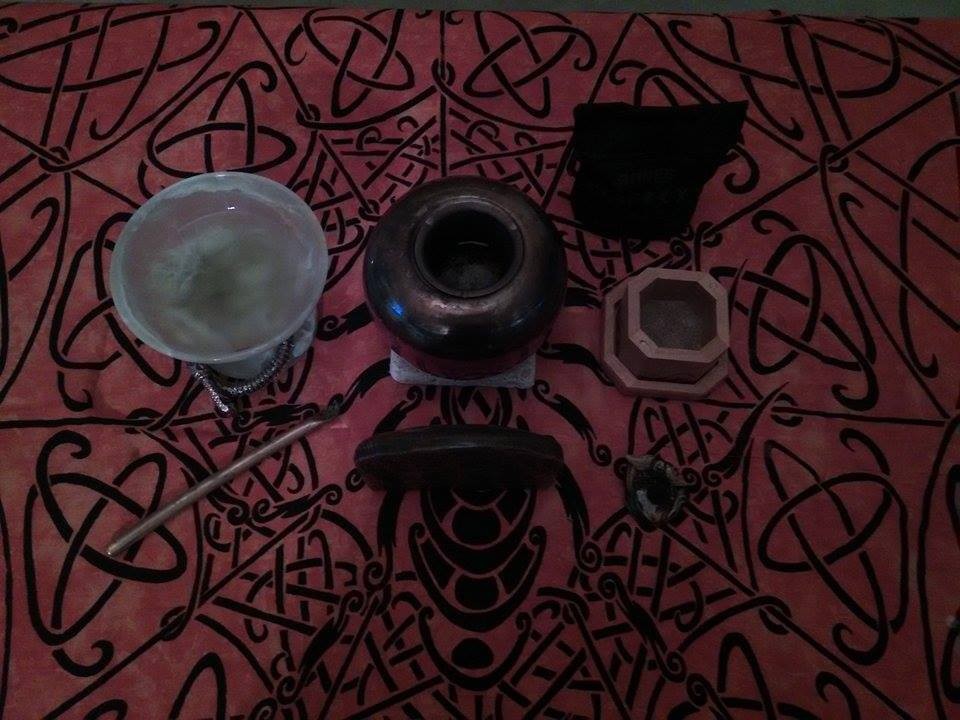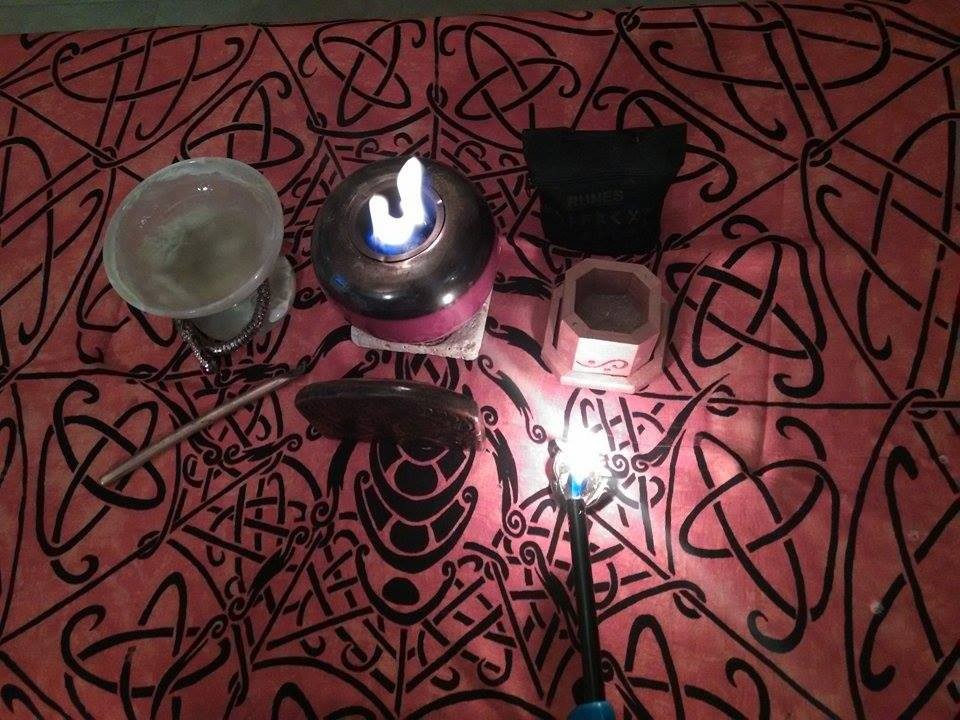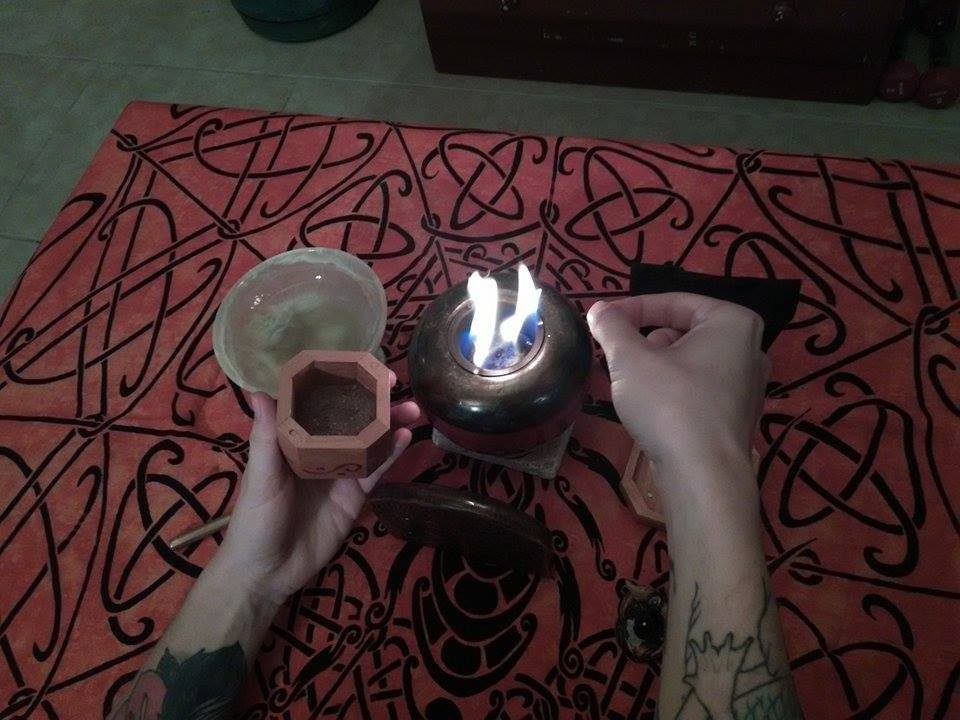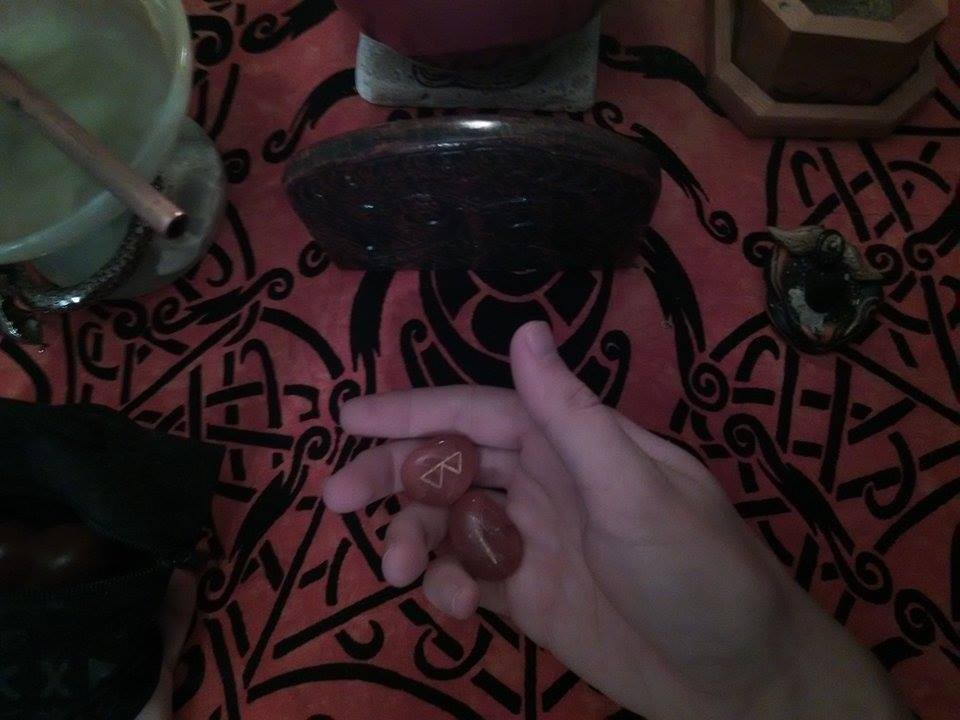Dagulf Loptson has been a devotee of Loki for 20 years and counting, following a childhood, love at first sight encounter. Despite his insistence that he was a Heathen, many gods from different traditions have become a part of his life over the years, who he loves and honors with the precarious balance of a trapeze artist. When he's not writing about gods, he's an graphic artist, a professional tattoo/piercing artist, and horror movie junkie. He is the author of "Playing With Fire: An Exploration of Loki Laufeyjarson", through Asphodel Press.

Breaking Loki’s Bonds
The following is intended to be a consecutive 9-day practice, ideally performed at night. In the Northern mysteries, nine is the number associated with initiation, death and rebirth. Each day begins with an invocation to one of the heiti (sacred names) of Loki, followed by a seated meditation, followed by a magical action to externalize what was experienced in the meditation. The goal of this practice is to identify a part or parts of yourself that have been hidden, scapegoated, or rejected, much like Loki himself was bound and outcast by the gods in Lokasenna and Gylfaginning. This may be an unsavory part of your past, a rejected aspect of your personality (whether good or bad), or a suppressed talent. True power stems from the acceptance and integration of yourself in all of your parts. To cut off and throw away parts of yourself that you see as taboo or undesirable is to cut yourself off from a potential source of your own power. This exercise is intended to help you identify and reintegrate with these parts of yourself, so that they can be transformed and used towards your personal empowerment.
What you will need:
- 1 medium-large candle to represent Loki’s presence. Colors associated with
- Loki are orange, red, yellow, black, and green.
- 3 small white candles which are large enough to carve runes into
- 1 knife or dagger sharp enough to cut through a ribbon.
- 1 black marker
- 1 red ribbon that is thick enough to write on and long enough to cut into three equal pieces
- 1 horn, chalice, or drinking vessel of your choice
- 1 pin or other etcher to carve candles with
- 1 unopened bottle of mead, wine, or other drink of your choice
- Lancets, or something else to draw a small amount of blood
- A small iron cauldron or fire-safe vessel in which you can burn the ribbon
- On day 7 you have the option of using a dremel
Day 1
Invocation:
Light your candle to represent Loki’s living presence, and speak this invocation:
Hail to Inn Bundi Áss (in-boondy-ows), bound god beneath the earth. I call to you, who speaks the hard truths so that we may be released from the shackles of our own making. I come to you in humility to learn the mysteries of self.
Every day after you speak the invocation, carry the lit candle around the circumference of the place in which you will be working in order to hallow the ritual space. Fire was often the vehicle of exorcism in Old Norse culture.
Meditation:
You look around, and find yourself on a grey, rocky outcrop beside the ocean. There is a chill in the air as the waves crash violently against the rocks, misting you with cold, briny water. The sun is nowhere to be found in the sky, and all you see when you look up is a thick layer of stormy grey clouds. A powerful gust of wind hits you, pulling violently at your hair and clothes. You know you have to find shelter soon. You look at the colorless scenery around you, and see what looks like the dark opening of a cave not far in the distance, facing the sea. You scrabble over the stony ground, tripping from time to time as your foot catches on a jagged stone, or the violent wind threatens to topple you. Finally, you make it into the opening in the rock face, and see that it leads into a dark, downward sloping tunnel. You hold your breath and cautiously begin to make your way deeper and deeper into the passage.
Though you have relief from the wind and the cold, a new kind of shiver makes its way down your spine as you hear the deep, distant echo of a scream from farther ahead. Suddenly, the ground begins to tremble violently, and you nearly lose your footing. But as almost as soon as the earthquake starts, it is over. Though you fear what lies ahead, you continue downward. Suddenly, the tunnel opens up into a large, dark cave. As you enter, you are met by a gust of horribly pungent air. The air stinks of acid, mingled with the smell of burning flesh and old blood, and you have to swallow to keep form choking. However, the smell is nothing compared to the sight that meets your eyes as you walk towards the center of the cave.
There is a man, naked and awkwardly stretched over three large, jagged stones. He is held in place by a strange, blood colored rope, wound tightly three times around his shoulders, his pelvis, and his knees. His long orange-blonde hair is streaked with blood, and he looks drawn and pale. From a distance, you can see that red blisters have bloomed on a face you are sure at one time was very handsome. His body trembles pitifully either from cold or pain. Standing over this man is an equally sad looking woman. She is holding a large, wooden bowl over the man’s face, into which a toxic-looking liquid is slowly dripping. Rags of clothing hang from her skinny arms and there are pale grey streaks in her strawberry hair. At first you think she’s an old woman, but as you draw closer you look into her face, fixed in concentration, and realize with a shock that she is actually a young woman, despite the hollows in her cheeks. Your eyes follow the green, dripping liquid upward, and you see an enormous black serpent coiled within the dead, dried roots that protrude through the stony ceiling. Venom trickles from its enormous fangs into the bowl below.
The man on the stones catches sight of you, and the red, welted skin around his eyes makes their green color violently bright. He signals you to come towards him with a jerk of his head, and though you feel both pity and revulsion, you come closer. As you do, the man speaks in a voice that sounds parched and exhausted:
“This is where the gods bound me, after I mocked I mocked them at Ægir’s feast. They didn’t like that I shone a light into the darkness of their hypocrisy, their pride, and their illusions of control. They thought they could cast off their flaws if they cast me out of Ásgarðr as their scapegoat, but they only make themselves weaker by trying to tame my flames. They keep me bound here, just as you keep the light of your own truth bound. You bind your inner fire, the might of your own divine Self, with fetters of your own making. You hide away those parts of yourself that you want no one to see; you lie to yourself and pretend to be something you’re not. But you will never be truly empowered until you accept yourself in all of your parts. Then the full might of your will can burn and transform the world around you. Will you release me from these fetters? Sacrifice the self you knew on the cremation pyre, so that something greater may arise?”
Magical Action:
Today, simply meditate on whether or not you are prepared to allow the god of change into your life to aid you in its transformation. Many people wish for change, and then curse the change and the one who brought it when it arrives out of fear. Are you ready to claim responsibility for yourself and the fruit of your own actions? Are you ready to see yourself as you truly are?
Day 2
Invocation:
Light your candle to represent Loki’s living presence, and speak this invocation:
Hail to Vé (vay) holy exorcist and illuminator of truth. Shine light into my dark places, so I can see that which I hide from others, but most importantly myself.
Carry the lit candle around the circumference of your working space.
Meditation:
You find yourself again within the darkness of the cave, beside the bound figure and his frail wife. She holds the wooden bowl over his head, her arms trembling but never falling. The venom hisses and smokes with every drop into the bowl. As you watch her, she motions to you to come closer. She seems pitifully frail and small next to you, but you can sense a deep, inner strength below her fragile surface: a fire that is shining dimly through the darkness.
“Look into the mirror and tell me what you see.”
She lowers the bowl slightly, so you can see your reflecting looking back at you in its venomous contents.
“Who do you have bound here?”
As she asks this question, you can see your reflection swirling and distorting in the green surface of the venom, until the face looking back at you reveals a part of yourself that you try to hide from the world and have banished into the darkness of your own subconscious. Is this person strong or weak? Kind or cruel? Brave or afraid? Whether good or bad, this is a part of yourself you want no one to see, or a part of yourself you have scapegoated and blamed for all of the ills in your life.
Magical Action:
Take the bottle of mead, wine, or other drink, and use the marker to write a name for your shadow-self or trait on the side of the bottle in runic script. Use a lancet to draw some blood, and put a dab on each of the runes, chanting the name of each rune as you do so to awaken the staves. Set the bottle aside and leave it unopened.
Day 3
Invocation:
Light your candle to represent Loki’s living presence, and speak this invocation:
Hail Læva Lundr (lie-vuh-loon-der), cunning spider that crouches in the tree of deceits. Allow me to see those places where I have been snared or have snared myself in the web of fate.
Carry the lit candle around the circumference of your working space.
Meditation:
You find yourself back in the cave. Sigyn lifts the bowl up towards the serpent. You turn your eyes to the red fetters that are holding Loki’s naked figure bound, and as you look more closely you can see that they aren’t ropes, but bloody sinews. Loki speaks to you again:
“These are the guts of my son Narvi. They are the only thing that keeps me from freedom: the final remnants of Sigyn’s child. The gods transformed his brother Váli into a wolf, and we watched him rip his brother to pieces before the cruel gods used his entrails to bind me to these rocks. It is my guilt that keeps me bound here, that I couldn’t save any of my children from the Æsir’s wrath. But what are the fetters that keep your spirit bound? What is holding your hidden self in place?”
As you look closer at the entrails, you are surprised to see that Loki no longer looks like himself, but has transformed into the naked image of the shadow self you saw in Sigyn’s bowl. The fetters have transformed as well, and instead of fetters, you see them transform into a symbol of what is holding down this part of yourself. Sigyn speaks to you. She speaks the name of the thing that is imprisoning you, whether this is a person, an emotion, a belief, or something else.
Magical Action:
Choose a word or name that describes the fetter that is binding you. Using the runes of the Elder Futhark, write this word/name onto the ribbon with your marker. Use the lancet to draw some blood, and empower each rune by dabbing it with some of your blood and chanting its name. Set the ribbon aside to use on a later day.
Day 4
Invocation:
Light your candle to represent Loki’s living presence, and speak this invocation:
Hail Ver Sigynjar (vehr-sig-in-yar), husband of Sigyn, friend to victory. Show me where my support stems from. Who is holding the bowl for me?
Carry the lit candle around the circumference of your working space.
Meditation:
Back in the cave, you see that Loki and his bindings are back to how they were when you first encountered them. You look into one of the cave’s dark corners, where you see a large, long metal box. Along the edges of the box, you see nine locks that hold the lid shut. Without turning his head, Loki follows your gaze to the box with his eyes. He speaks to you again:
“To break these bonds, you will need a suitable weapon. That is the box that holds my sword Lævatein, which I forged in Niflhel and will brandish at Ragnarök. Surtr’s wife Sinmara guards it for me, and keeps it in a box with nine locks. To reveal this weapon, you will have to discover the keys that open these locks. Search within yourself to find them.”
Who are your allies that will give you the strength of resolve to break these bonds? Are they a spirit, an ancestor, a god, or a person in your life? Are they a principle, a talent, or a virtue? What three things hold the key to your empowerment?
As you look towards the box, you suddenly feel a weight in your pocket. You reach inside your pocket, and pull out the first key. What does the key look like? What color, shape, and size is it? On the side of the key, you see a word engraved on the side. This word reveals the identity of your first ally. You walk to the box, and insert the key into the first three locks. One after the other, you hear the heavy “click” of the locks opening, and the sound echoes through the hollow chambers of the cave.
Magical Action:
Take one of the small white candles and use your etcher to carve the word you saw on the key into the candle in the runic script. Using your lancet, put a dab of blood onto these runes and chant their names to awaken them. When this is complete, light the candle in honor of your ally. If this is a god, spirit, or ancestor, ask them for their aid in your liberation. If this represents a living person, speak a prayer of blessing on their behalf. If it represents a personal talent, code of honor, or virtue, meditate on how you are (or are not) implementing it in your life. When you are done, extinguish the candle and save it for the next day.
Day 5
Invocation:
Light your candle to represent Loki’s living presence, and speak this invocation:
Hail Lóðurr (low-thur) mighty creator who gives the children of Midgarðr their spark of life. Illuminate the allies who will help me release the fire within.
Carry the lit candle around the circumference of your working space.
Meditation:
Back in the cave, you place your hand in your pocket again and pull out the second key. Examine its appearance, and turn it over until you see a word engraved on its side. This word reveals the identity of your second ally. You turn to the box once again, and unlock the next three locks with this key, one after the other.
Magical Action:
Repeat the process from yesterday with the second ally/candle. When you have carved and blooded the candle, light todays and yesterdays candle during your meditation. Extinguish them both when you’re done meditating on their meaning and save them for tomorrow.
Day 6
Invocation:
Light your candle to represent Loki’s living presence, and speak this invocation:
Hail In Slægi Áss (in-sly-ee-ows), most cunning of the gods in the nine worlds. Show me the identity of my final ally so that I may open the locks that hold the object of my freedom.
Carry the lit candle around the circumference of your working space.
Meditation:
You are back in the cave. For a third time, you examine your pocket and pull out the third and final key. Examine the last key, and find the engraving that reveals the identity of your third ally on its side. You use the key to unlock the three final locks on the box, and with some effort are finally able to pull open its heavy lid to reveal what lies inside. Within the box, you see a long, razor sharp sword. Serpents decorate its hilt, and the reflective metal of the blade burns with its own inner, blue fire.
Magical Action:
Perform the same action you did for the first two candles. When the third candle is carved and blooded, light all three candles during your meditation. As they burn, breathe deeply, and imagine the might of your three allies flowing from the candle flames into your body through your breath. Allow the three candles to burn themselves out.
Day 7
Invocation:
Light your candle to represent Loki’s living presence, and speak this invocation:
Hail Loptr (lof-ter), mighty serpent of fire who treads the sky with thunder. Fill me with your heavenly knowledge and show me the source of my liberation.
Carry the lit candle around the circumference of your working space.
Meditation:
Back in the cave, you still find yourself gazing at the weapon that has been revealed. As you gaze into the reflective surface of the blade, the true identity of this sword is revealed to you. An image appears in its surface, which will show you what being, force, or course of action will allow you to break through the fetters that are binding your hidden self. Meditate on the image you have been shown for a moment, as it is of the utmost importance to use its wisdom not just during the course of this meditation, but in your mundane life as well.
From behind you, you hear Loki scream again as Sigyn runs to the side of the cave to empty her bowl of its venomous contents. As the acid drips onto his upturned face you smell smoke and burning flesh. The earth trembles beneath your feet as Loki struggles in his bonds against the poison. Sigyn quickly runs back to her husband and assumes her position above him. The earthquake abruptly ceases.
Magical Action:
Meditate on what you saw in the blade’s surface, and find a word to describe and name it. Write that name onto your ritual blade with the marker (alternately you can use a dremel to etch the runes in). Draw some blood and put a dab on each of the runes, chanting the rune’s name to awaken each one.
Day 8
Invocation:
Light your candle to represent Loki’s living presence, and speak this invocation:
Hail Hveðrung (Kveh-thrung), roarer, mighty harbinger of Ragnarök who wields the wand of destruction. May I have the resolve to set fire to my stagnation so that a new self may arise from the ashes.
Carry the lit candle around the circumference of your working space.
Meditation:
You are back in the cave. You reach into the box and grip the sword by the hilt. You feel a current of power travel up your arm as you do so. With some difficulty, you pull the heavy sword out of the box and walk towards where Loki and Sigyn are waiting. You fix your eyes on the fetters, taking a moment to breath and remember the true name of the fetter you are actually destroying. You lift the sword over your head, and with a powerful swing the sword cuts cleanly through the fetter binding Loki’s shoulders with one meaty slice. Though the fetters seemed so powerful and strong on the outside, they were much more fragile than they first appeared. The illusion of their strength has been broken. You lift the sword a second time, slicing through the fetter binding Loki’s pelvis. The sword slices easily through this fetter as well, clanging on the rock lying beneath it. You lift the sword a third time, and slice through the last fetter binding Loki’s knees.
Magical Action:
Take the ribbon in your hand, and take a moment to focus on its true name and identity. Take your knife and slice through the ribbon in three places, symbolically releasing yourself from your old bondage. Set the pieces aside for tomorrow.
Day 9
Invocation:
Light your candle to represent Loki’s living presence, and speak this invocation:
Hail Gammleið (gam-layth), vulture’s path, lord of cremation. Burn away the refuse of my old bondage so that my hidden self may be released and I can be reborn anew.
Carry the lit candle around the circumference of your working space.
Meditation:
As the last fetter is cut and Loki is released from his prison, the darkness of the cave is suddenly filled with a bright, blinding light. Loki rises from the stones, no longer drawn, weak, and injured, but blazing with red and gold flames and radiating power. His green eyes shine like emeralds, and wild laughter escapes from his scarred lips. The serpent above him has retracted its fangs, no longer the trickster god’s oppressor. It drops down to meet him, wrapping itself around his shoulders: the symbol of his power restored. You suddenly feel the heat of his flames surrounding you, eating away at your flesh as if you were a corpse on a funeral byre. He burns away your falsities, your illusions, and your masks. His flames strip you bare until nothing but the true image of your whole Self is what remains.
You turn to Sigyn, and see that she too has been transformed. She has gone from the trembling waif holding the crude, wooden bowl to a woman blazing with power. She is dressed in a cloak of swan feathers, her strawberry hair framing a gentle but strong face. The bowl that once held her prisoner has been replaced with a golden chalice, and the venom within has been transformed into sweet, golden mead. The goddess of victory offers you the chalice: the hidden self that was once your poison has now become your medicine. She bids you to drink with these words:
“Mead I bring thee, tree of battle,
Mingled with strength and mighty fame;
Charms it holds and healing signs,
Spells full good, and gladness-runes”
You take the cup and drink deeply of the mead, burning a trail of bright fire down your throat and into your body. The hidden self whom you rejected has now been reintegrated into yourself: making you healed and whole. The trickster and his consort have helped you to release the shackles of self-deception, and have initiated you into the mysteries of self-knowledge. You turn towards the two deities, and ask them if they have any more words of advice for you before you leave the cave and return to the mundane world. Whatever wisdom they share is to serve you on your path alone.
As you begin to walk up and out of the cave, you see light streaming through its entrance. The dark clouds that once filled the sky are gone, and the sun is shining brightly upon the calm sea. Walk forward into the world transformed, with power and authenticity.
Magical Action:
Open the bottle of mead, wine, or whatever drink you have chosen. Pour the liquid into the horn or cup and chant the runes that make up the name you gave to your shadow-self into the liquid. Next, take the three pieces of ribbon and put them in the cauldron or another fire-safe vessel. Set fire to the ribbon pieces using the flame from Loki’s candle. Hold the horn or chalice over the flame of Loki’s candle and imagine that the liquid is filled with the cleansing flames, transforming what was once the poisonous nature of your shadow self into an elixir of healing and empowerment. Take a deep breath, hold it, and then drink the liquid down in one draught. Make an oath to yourself that rather than rejecting whole parts of yourself, you will transmute them and integrate them back into your sphere of power. The venom of the serpent is the same medicine that can cure its bite.


